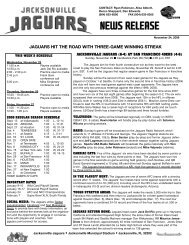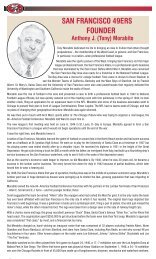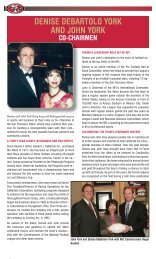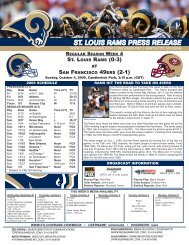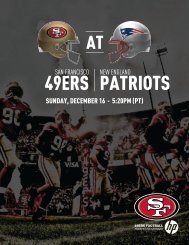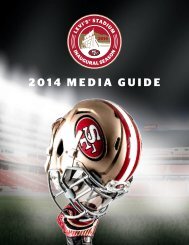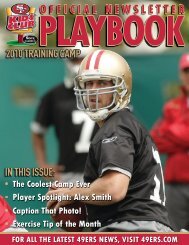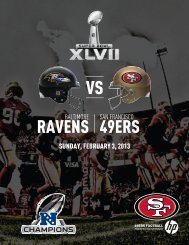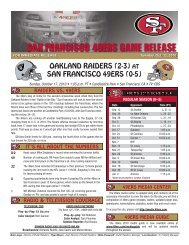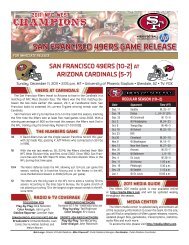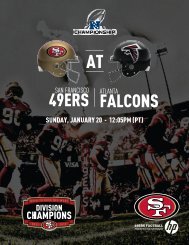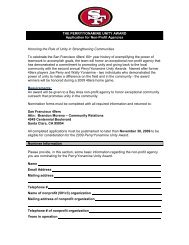1 - Organization-For Print.indd - Parent Directory - NFL.com
1 - Organization-For Print.indd - Parent Directory - NFL.com
1 - Organization-For Print.indd - Parent Directory - NFL.com
Create successful ePaper yourself
Turn your PDF publications into a flip-book with our unique Google optimized e-Paper software.
HISTORYANTHONY J. MORABITOSAN FRANCISCO 49ERS FOUNDERAnthony J. (Tony) Morabito(1910-1957)Tony Morabito dedicated his life to bringing anidea to fruition that others thought preposterous– the membership of the West Coast, in general,and San Francisco, in particular, in a nationwideprofessional football league.Morabito was the sports pioneer of the West,bringing San Francisco its first major leagueprofessional team, the San Francisco 49ers, in aprofessional sports business that was dominatedby the East Coast. Before World War II, Morabitowas convinced the San Francisco Bay Area was readyfor a franchise in the National Football League. The Bay Area was a mecca forcollege football. Fans came in droves to Kezar Stadium to see the Wonder Teams ofCalifornia-Berkeley and the Wow Boys of Stanford, led by Frankie Albert. St. Mary’s,Santa Clara and the University of San Francisco were also area powerhouses thatregularly defeated the University of Washington and Southern California inside thewalls of Kezar.Morabito saw the rise of football in the area and presented a case to birth aprofessional football team in 1942 to National Football League officials, but hewas quickly ushered out of the meeting room with firm politeness. In the springof 1944, he took another crack, filing an application for an expansion team in the<strong>NFL</strong>. Morabito and some of his business associates went to Chicago to present theirplan in front of League Commissioner, Elmer Layden. The <strong>NFL</strong> had no teams west ofChicago, and had no plans of changing their geographical structure. Morabito wasagain shunned.He was then put in touch with Arch Ward, sports editor of The Chicago Tribune whowas trying to organize a rival league, the All-America Football Conference. Morabitotold Ward to count him in.The new league’s first meeting was held on June 6, 1944 in St. Louis, D-Day inEurope. Morabito agreed to form a San Francisco franchise in a league that wouldnot begin operations until the end of the war.It was the right time, and Morabito knew it.A native of San Francisco, Morabito learned the game of football on vacant lots inthe North Beach sector and had some success later as a halfback at St. IgnatiusHigh School. He went on to play for the University of Santa Clara as a freshmanin 1927 but his playing career was ended shortly after by a shoulder injury. Hereceived his diploma in 1931 at the height of the Great Depression. He got a jobdriving a truck for $80 a month while his father, an immigrant from Italy, had builtup a flourishing ship’s service business on the San Francisco waterfront, only to seeit fold in the wake of the depression years.As the country’s economic state began to improve, so did Morabito’s. By 1940,when he was 30 years old, he became a success in the lumber carrier business.The army turned him down for duty in 1942 because of partial deafness, which laterforced him to wear a hearing aid.By 1946, the San Francisco 49ers first year of operation, the Bay Area was in themiddle of a postwar economic surge. Morabito’s lumber yard was in huge demandas houses were springing up to shelter the fast-growing population that wasmigrating to California.Morabito owned the new All-America Football Conference franchise with hispartners in the Lumber Terminals of San Francisco – Allen E. Sorrell and E.J. Turre– and his younger brother, Victor.Sorell suggested the team be named “49ers” after the voyagers who had rushedthe West for gold. It is the only name the team has ever been affiliated with andSan Francisco is the onlycity in which it has resided.The original team logodepicted San Francisco’swild beginnings. It was agoldminer in boots and alumberjack shirt, firing apair of pistols. One shot justmissed the miner’s head,while the other missed hisfoot. The logo was takenfrom a design seen on the49ers Founder, Tony Morabitoside of railway freight cars.SAN FRANCISCO 49ERS \\344With a charter, name and logo, the grouprecruited Lawrence “Buck” Shaw, SantaClara’s famous “Silver Fox,” as the 49ersfirst head coach. The organization spent$250,000 to get structured before theteam even took their first snap. Morabito’sapproach was considered “first class,” bymost, and a financial risk by many.But Morabito charged on, hand-pickingan inaugural roster <strong>com</strong>prised of 32players including Frankie Albert, NormStandlee and Bruno Banducci, all fromStanford, and stars from Santa Clara,including Alyn Beals, an end who scored46 pro touchdowns in four years. Otherknown players on the roster were LenEshmont, Johnny “Johnny Strike”Strzykalski and Joe “The Toe” Ventrano.Morabito watched as his 49ers played their first game on August 24, 1946, a17-7 exhibition win over the Los Angeles Dons at Balboa Park in San Diego. The49ers first home game was played at Kezar Stadium on September 1, 1946, a34-14 exhibition win over the Chicago Rockets in front of 45,000 fans made up oflongshoremen, draymen, mechanics and waterfront workers.The first regular season league game was on September 8, 1946 against theNew York Yankees. The 49ers scored first, but lost 21-7 in a game that began insunshine and ended in the famous Kezar fog.The 49ers finished 9-5 in their first season under Shaw, and went on to have an8-4-2 record in 1947, 12-2 finish in 1948 and 10-4 record, including a trip to theChampionship Game, in their final season in the AAFC.At the end of 1949, it was announced that the AAFC had run its course. SanFrancisco, Cleveland and Baltimore received <strong>NFL</strong> franchises and would begin playin the <strong>NFL</strong> in 1950. The merger was what Morabito had hoped for all along as he,his brother Victor and general manager Lou Spadia, continued to hold the reins.The 49ers struggled during their first season among the <strong>NFL</strong> elite, finishing with a3-9 record. The following year though, the 49ers went 7-4-1.As the seasons went on, Morabito was the heart and soul of the organization,signing on greats like The Million Dollar Backfield: Joe “The Jet” Perry, Hugh “TheKing” McElhenny and John Henry Johnson. He also attracted some of the <strong>NFL</strong>’smost renowned talents in R.C. Owens, Bob St. Clair, Leo Nomellini, John Brodieand Y.A. Tittle.The players appreciated his honesty, and trusted his every move and word.As the 1950’s progressed, Morabito was warned by his doctors that a bad heartand the rigors of football were not a healthy <strong>com</strong>bination. But Morabito wasn’tgoing to let a health scare get in the way of his passion. “What the hell, if I’m goingto die, I might as well die at a football game,” he said.On October 27, 1957, the 49ers hosted the Chicago Bears at Kezar. The 49ersentered the game with a 3-1 record behind the talents of Owens, Perry, Tittle,McElhenny, Billy Wilson, and others. The Bears had a 14-0 advantage in the firstquarter before the 49ers scored to close the deficit at 14-7. Just as the 49ers linedup for the next kickoff, Morabito, who was sitting next to his wife, Josephine, andhis brother, Victor, in the guest box, suddenly collapsed. The great heart that hadbeen with the 49ers since the franchise’s inception had failed.Father Bill McGuire of St. James parish was summoned to the guest box andpronounced Morabito his final absolution. Morabito looked up at him and smiled.“Thank you father,” he said.Those were his last words.The 49ers were behind 17-7 in the third quarter when the team learned ofMorabito’s death. His players rallied and came back to defeat Chicago, 21-17,in an emotional last win for their owner. The 49ers finished the season with threestraight victories and an 8-4 record, tying Detroit for the <strong>NFL</strong> Western Division title.Victor, Tony’s younger brother, kept the team in the family until 1964, when hetoo died of a heart attack. Both Victor and Tony’s wives, Jane and Josephine,retained control of the 49ers with Lou Spadia as team president until 1977, whena new team owner, Edward DeBartolo Jr. of Youngstown, Ohio emerged to buy thefranchise.Morabito’s conviction, passion and character birthed and kept an <strong>NFL</strong> franchise inSan Francisco, and laid the sturdy foundation that enabled the 49ers to be<strong>com</strong>eone of the <strong>NFL</strong>’s premier football powers over the past 60 years.// MEDIA GUIDETony Morabito’s widow, Josephine (left),and Victor Morabito’s widow, Jane (right),kept control of the 49ers after their husbands’passing along with team presidentLou Spadia (middle).



